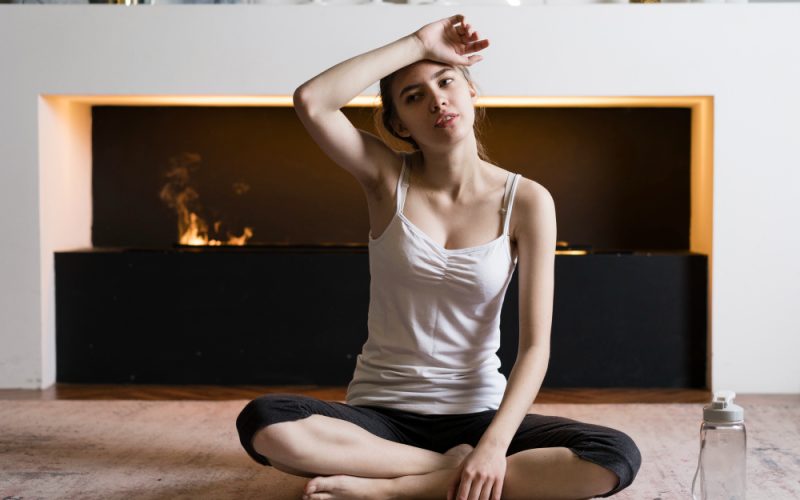1. Introduction
Have you ever tossed and turned in bed, unable to sleep because your mind keeps racing? Or perhaps you woke up with a headache that only seems to get worse as the day goes on? You’re not alone—many people struggle with both sleep and headaches. Here’s the thing: improving sleep can reduce headaches, and one of the best ways to tackle both issues is through yoga and meditation. These simple, accessible practices can help you relax your mind and body, leading to better sleep and fewer headaches. In this blog, we’ll explore how yoga and meditation can be your go-to tools for better rest and headache relief.
2. Why Are Sleep and Headaches So Closely Linked?
If you’ve ever suffered from sleepless nights, you know how much it affects your overall well-being. But did you know that poor sleep can actually make headaches worse? It’s a vicious cycle: when you don’t sleep well, your pain sensitivity increases, making you more likely to experience tension, headaches, or migraines. On the other hand, frequent headaches can make it hard to get enough rest, leaving you feeling stuck.
Studies have shown that chronic sleep problems are linked to more frequent headaches. This is particularly true for tension headaches, which are often caused by muscle tightness and stress. Thankfully, yoga and meditation can address both issues by helping you relax and ease the physical and mental tension that leads to sleep disturbances and headaches.
3. How Yoga Eases Tension That Triggers Headaches
When you’re stressed or sitting for long hours, your neck, shoulders, and jaw can become tight, leading to tension headaches. Yoga is an excellent way to relieve that tension. Certain poses are specifically designed to stretch and relax the muscles that are prone to tightness, reducing the frequency and intensity of headaches.
Here are a few yoga poses that can help:
- Child’s Pose: This gentle stretch for your back and shoulders releases tightness in the neck and upper back.
- Legs-Up-the-Wall: Great for calming your nervous system and easing leg tension, which can also help with headache relief.
- Cat-Cow: This simple movement helps to loosen the neck and spine, improving circulation and relieving built-up stress.
As you practice these poses, try mindful breathing to enhance the calming effects. The combination of movement and breath helps your body shift out of fight-or-flight mode, reducing the physical stress that contributes to headaches.
4. Can Meditation Really Help You Sleep Faster?
Let’s face it: sometimes, the hardest part of going to sleep is calming your mind. Whether it’s racing thoughts, stress from the day, or anxiety about tomorrow, falling asleep can seem impossible. That’s where meditation comes in.
Meditation helps quiet your mind, reduce stress, and set the stage for restful sleep. Specifically, mindfulness meditation and body scan techniques are great tools for falling asleep faster. These practices teach you to focus on the present moment and relax each part of your body.
Here’s how meditation benefits your sleep:
- Reduces cortisol: Meditation lowers stress hormones that prevent restful sleep.
- Slows heart rate: Deep breathing and focused attention help your heart rate slow down, signaling to your body that it’s time to rest.
- Improves melatonin production: Meditation can support the natural production of melatonin, the hormone responsible for regulating your sleep cycle.
You don’t need hours of meditation to see results. Start with just 5–10 minutes before bed to calm your mind and prepare your body for deep, rejuvenating sleep.
5. Simple Night Routine with Yoga and Meditation for Better Sleep
A consistent routine is key to improving your sleep. By adding a combination of yoga and meditation to your evening ritual, you can signal to your body that it’s time to wind down. A short, relaxing routine can ease tension and calm your mind, helping you get to sleep faster and stay asleep longer.
Here’s a simple, calming night routine:
- 5 minutes of gentle yoga: Try poses like Child’s Pose, Forward Fold, and Legs-Up-the-Wall to stretch and relax your muscles.
- 10 minutes of guided meditation: Focus on your breathing or use a body scan technique to release any remaining tension.
- End with quiet time: Avoid screens and bright lights for at least 30 minutes before bed.
Why does this work? A routine like this not only prepares your body for sleep but also helps your mind slow down after a busy day. It reduces overstimulation and helps you avoid the stress that can prevent sleep.
6. What to Do During a Headache: Yoga or Meditation?
Sometimes, you don’t have time for a full yoga or meditation session, but a headache still strikes. So, what can you do in the moment to find relief? Both yoga and meditation can help you manage headache pain right when it hits.
- Restorative yoga: Simple, gentle stretches can help alleviate the tension building in your neck and shoulders.
- Supported Child’s Pose: Rest your forehead on a cushion or blanket to soothe your mind and reduce neck tension.
- Gentle Forward Fold: This pose can help calm your nervous system and relieve tightness in the neck.
- Meditation: When you’re in pain, even a few mxinutes of deep breathing can help. Sit in a quiet space, close your eyes, and focus on your breath. Imagine the pain slowly dissipating with each exhale.
If you’re dealing with a migraine, avoid intense or inverted poses, as they may exacerbate the pain. Opt for stillness, dark surroundings, and slow breathing instead.
7. Real Benefits People Have Seen with These Practices
People who incorporate yoga and meditation into their daily lives often report significant benefits. Here’s what you can expect if you stick with these practices:
- Faster sleep onset: You’ll fall asleep more easily and avoid the endless tossing and turning.
- Reduced headache frequency: Regular yoga and meditation help keep muscle tension and stress at bay, leading to fewer headaches overall.
- Deeper, more restful sleep: As your mind and body relax, your sleep quality improves, and you wake up feeling more refreshed.
Many people find that these benefits don’t happen overnight, but with consistent practice, the changes become noticeable. You might even start to notice that your sleep feels deeper and more rejuvenating after just a few weeks.
8. Tips to Stay Consistent Without Feeling Overwhelmed
The key to seeing real results with yoga and meditation is consistency. But how do you stick with it when life gets busy? Here are some tips to help you stay on track:
- Start small: You don’t need a long, complicated routine. Start with just 5–10 minutes daily.
- Use apps or timers: Set a timer or use a guided meditation app to help you stay focused and consistent.
- Make it part of your routine: Just like brushing your teeth, make yoga and meditation a regular part of your evening ritual.
- Track your progress: Keep a journal or use a sleep tracker to monitor improvements in your sleep and headache frequency.
Don’t stress if you miss a day—just pick it up the next time. Consistency is key but so is being kind to yourself.
Conclusion
In conclusion, incorporating yoga and meditation into your daily routine can be a game-changer for improving both sleep quality and reducing headache frequency. These practices help to relax the mind, ease muscle tension, and create a peaceful, restorative environment that promotes restful sleep. By dedicating just a few minutes each day to these simple techniques, you can break the cycle of stress and pain, leading to better overall well-being. Whether you’re dealing with sleep difficulties or frequent headaches, yoga and meditation offer an accessible and effective solution for lasting relief.












